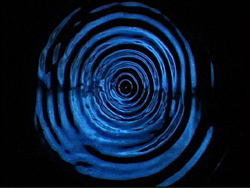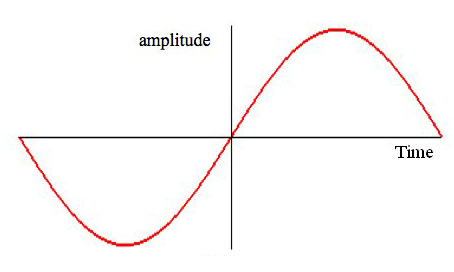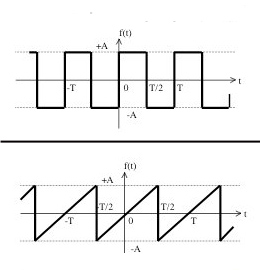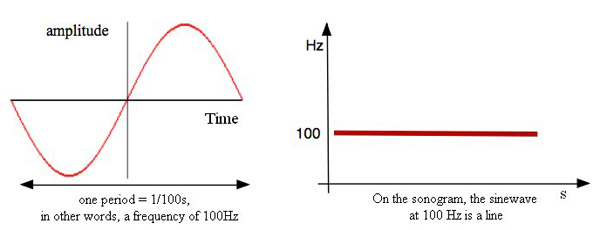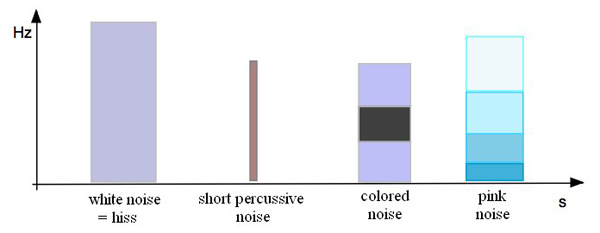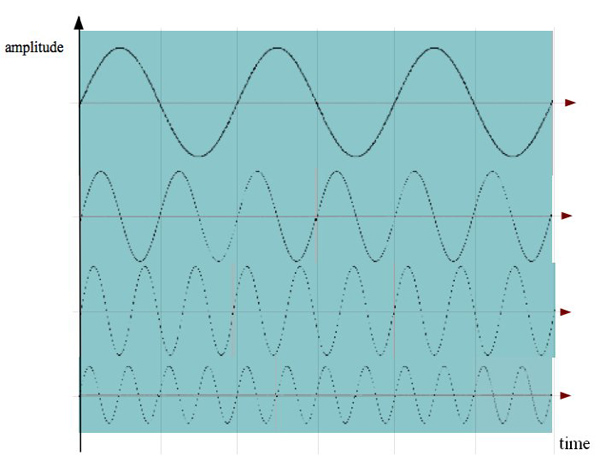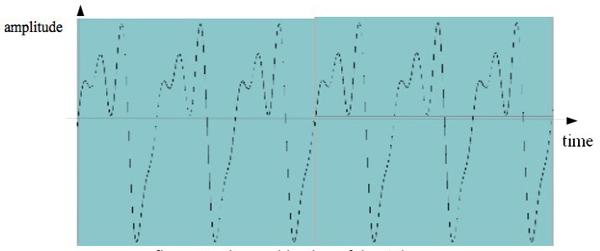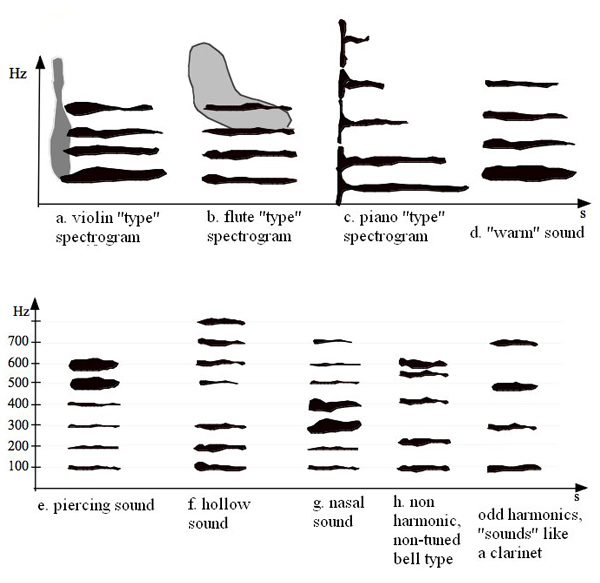
Timbre is a sound’s identity.
This identity depends on the physical characteristics of the sound’s medium (the matter or substance that supports the sound). Let’s take an A at 440 Hertz produced at 60 decibels: we can immediately tell if the sound was emitted from a violin, saxophone, or piano.
Yet, even though the instrument is different, it’s the same note and the same amplitude. The difference is in the sound production: string, air column, etc..
Plus, the sound isn’t generated by the same “tool”: a bow for violin strings, a reed and an air column for the sax, and felt covered hammers that strike the piano strings. It’s the different physical characteristics of the medium and the «tool that determine the characteristic sound waves in each case.
Later we will also see how a sound chamber adds another dimension to this definition.
Waveform
The most basic waveform is a sine wave (sinusoid) (Figure 1). It could be considered the atom of sound.
Pure sinusoidal sounds are rare (i.e., tuning forks, drinking glasses being rubbed) and were considered to have strange powers over human behavior at one time. Most sounds that surround us are of a more complex nature.
This means that inside a sound, that we perceive as being unique, there is a superposition of many sine waves that have, in a way, fused together to become one sound.
It’s the nature of this superposition itself that determines the resulting waveform (Figure 2) and that is responsible for its timbre. This is called a spectrum.
Spectral Representation
There are many ways of graphically representing sound. For instructional purposes we have chosen to use a spectrogram for its clarity and simplicity.
Horizontally: time in seconds. vertically: frequency in Hertz. A sine wave (sinusoid) at 100 Hertz is represented by a horizontal line at a height corresponding to 100. (Figure 3)
A harmonic sound at 100 Hertz is represented by superimposed lines corresponding to sine waves of 100, 200, 300: n x 100 Hertz. The length of the lines represent the length of the sound.
Noise
Let’s imagine a case where all sine wave frequencies that are perceptible to the human ear (from 20 Hz to 20 kHz) and having the same amplitude, are “mixed” into one sound signal.
We get what is called “white noise,” or in other words, “hiss.” If the white noise is very short we would perceive it to be a kind of short percussive sound. Consonants belong to this category, in the same way that a sound medium that receives the attack of the “tool” which “kick-starts” it, produces as noise. This noise corresponds to the time it takes for the sound wave to stabilize and take its final form.
The “rubbing” of a bow on a string is similar to a hissing sound, while a hammer hitting a piano string is similar to a percussive sound. These notions will be dealt with in greater depth when we get to envelopes and transients. In the case where a series of noise frequencies is contained between certain limits we will refer to them as noise bands.
If a zone is particularly swollen in energy, then we can speak about colored noise around that zone. Pink noise is white noise with a power density that decreases by 3 dB per octave.
Harmonic Sounds
Having already highlighted the superimposed or complex aspect of sound, we are now going to focus on a specific category of frequencies in a sound spectrum: harmonics.
A harmonic sound is a sound which contains sine waves that obey the mathematical law called the Fourier series. This law translates as follows: A complex periodic signal is made up of a certain number of component frequencies that are integers of the fundamental frequency.
An example of a harmonic sound: a sound at 100 Hz in which the component waves are 100, 200, 300, 400, 500 and 600 Hz. The perceived pitch is the lowest frequency: 100 Hz.
The following component waves (2 x 100, 3 x 100, 4 x 100, etc.) are calculated on integers and are called harmonics. The lowest frequency, on which they are based, is called the fundamental.
The number, or “rank,” of a harmonic is the integer by which the fundamental is multiplied. For example, the 3rd harmonic would be the one at 300 Hz. (Figure 5 a-c)
The pitch of a harmonic sound is easily perceptible to the ear, and these sounds usually have an “in tune” quality about them. That’s why melodic musical instruments are designed with the goal of producing harmonic spectrums.
Noises, like those we referred to earlier, are aperiodic signals. They are characteristic of percussion instruments, for example.
Distribution Of Energy In The Spectrum
Regions of relatively great intensity in a sound spectrum are called formants. In the case of a band of consecutive frequencies it is referred to as a formant zone between x and y Hertz (Figure 6).
This distribution of energy plays an important role in the perception of timbre, as do the number of components in the spectrum, their distribution, and its regularity or non regularity. Figure 7 provides some graphic examples.
a – violin: a hiss noise at the attack, harmonic spectrum
b – flute: harmonic spectrum
c – piano: noise of the hammer attack, percussive sound and spectrum not quite regular in its harmonics
d- warm sound: few harmonics but regular distribution of the energy from low to high
e – piercing sound: harmonic sound with a lot of intensity in the highs
f – Hollow sound: few harmonics in the mids
g – nasal sound: weak lows, intense mids, weak highs
h – non harmonic sound: like a non-tuned bell
I – square signal, odd harmonics: like a clarinet sound


